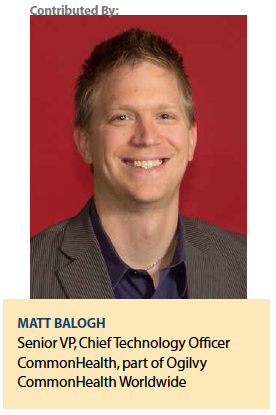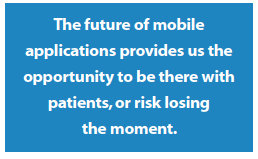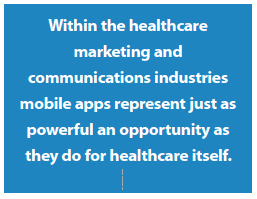The year 2013 officially marked the arrival of mobile with more than 50% smartphone adoption in all major markets. Though many organizations had dabbled, mobile-first strategies catapulted to the top of nearly all marketing priority lists. But in the rush to adopt in 2014, industries have struggled to leverage the real power of the device.
many organizations had dabbled, mobile-first strategies catapulted to the top of nearly all marketing priority lists. But in the rush to adopt in 2014, industries have struggled to leverage the real power of the device.
As is true for most new channels, industry’s first inclination was to take what we know and retrofit it. Print became Web that later added interactivity, culminating in the Web 2.0 shakeout. From there, Web became responsive as mobile got added to the mix, and mobile engagements prioritized cross-platform apps that are limited in functionality.
The Mobile Evolution
So now it’s 2015 and the table has been set to go deeper into mobile than ever before. Late last year Apple released HealthKit, followed quickly by Google Fit, and Microsoft Health, each giving us unprecedented access to health and wellness information. In March of this year Apple released ResearchKit, again giving researchers unprecedented access to audiences for clinical trials. And with these advancements has come the realization that the true power of smartphones and tablets in healthcare has begun to unleash in the form of apps.
Real-Time Opportunities for Real-Time Results
 The full power of these devices, which can only be leveraged entirely by native apps, is a unique opportunity for both healthcare and marketers to become more personal, contextual, and engaging. It is an opportunity to partner with patients and support them continuously throughout their care journey, in real time, when and where they need it most. It is an opportunity to intentionally architect and coordinate seamless transitions between the numerous moments of truth that reach across channels and far beyond the office setting.
The full power of these devices, which can only be leveraged entirely by native apps, is a unique opportunity for both healthcare and marketers to become more personal, contextual, and engaging. It is an opportunity to partner with patients and support them continuously throughout their care journey, in real time, when and where they need it most. It is an opportunity to intentionally architect and coordinate seamless transitions between the numerous moments of truth that reach across channels and far beyond the office setting.
Apps, when combined with location-based services and sophisticated care coordination platforms, provide a central hub for the synchronization of disparate health providers. Direct messaging though push messaging, notifications, and reminders increasingly allow appropriate communication at the right time and place, where and when it can do the most good. As a result, adherence to both health and wellness regimens can be affected, driving outcomes toward greater overall health and better management of chronic conditions. Expedited by meaningful use requirements, integrated EMR systems are taking hold, further driving outcomes-based standards of care and increasing the importance of beyond-the-pill wellness in the overall treatment of patients.
Committing to the App
For the truly committed, prescription mobile apps represent fertile ground ripe for exploration. As recent as February of 2015, the FDA released guidelines on mobile medical apps, citing as the FDA’s top priority those that function as medical devices and present risk to patients if they do not function appropriately. With that risk, however, comes great benefit to healthcare as diagnosis and treatment migrate outside of traditional settings with high-resolution video and sensors, and patients are empowered to manage their own health and wellness.
 Within the healthcare marketing and communications industries mobile apps represent just as powerful an opportunity as they do for healthcare itself. Outcomes-based medicine has fused the focus of the pharmaceuticals industry, and the marketing that supports it, around positive patient outcomes.
Within the healthcare marketing and communications industries mobile apps represent just as powerful an opportunity as they do for healthcare itself. Outcomes-based medicine has fused the focus of the pharmaceuticals industry, and the marketing that supports it, around positive patient outcomes.
There is no better marketing for a product than one that is effective, and there is no better way to be effective than to continuously care for patients in real-time, on their terms. Mobile apps are how we do this at scale.
Within healthcare and the marketing that supports it, mobile apps are the next evolution in mobile. These complex devices are no longer a straight substitution for the former interactive leader, the website. The always-on, always with us, integrated hub of our life, adoption of the smartphone has shifted consumer expectations to that of immediate gratification. With this shift comes the marketing and healthcare imperative to become omnipresent, partnering with patients on their journey as they progress through the many moments of truth which carry them forward.
The future of mobile applications provides us the opportunity to be there with them, or risk losing the moment. (PV)
Ogilvy CommonHealth Worldwide — the health behavior experts of Ogilvy & Mather — is committed to creativity and effectiveness in healthcare communications, everywhere.
For more information, visit ochww.com.










